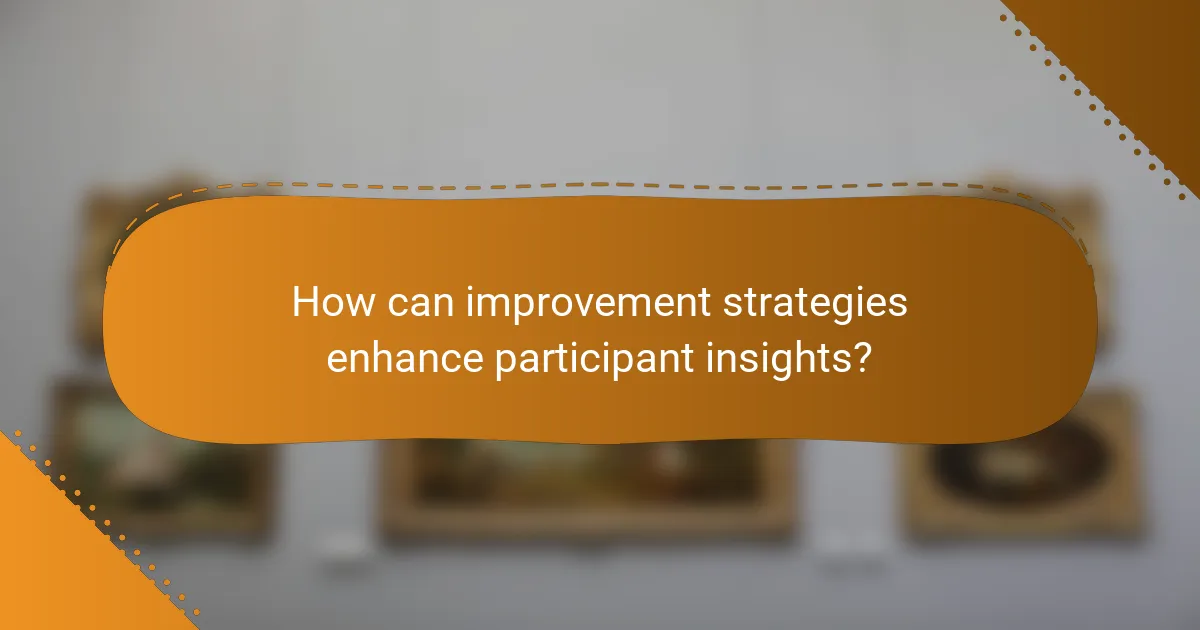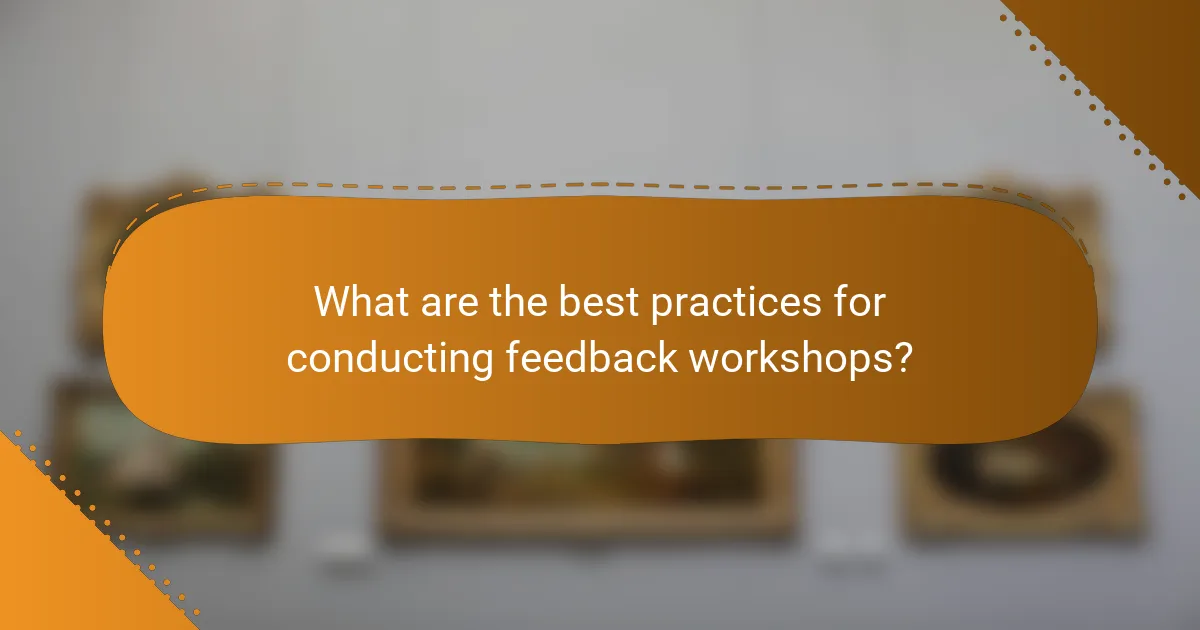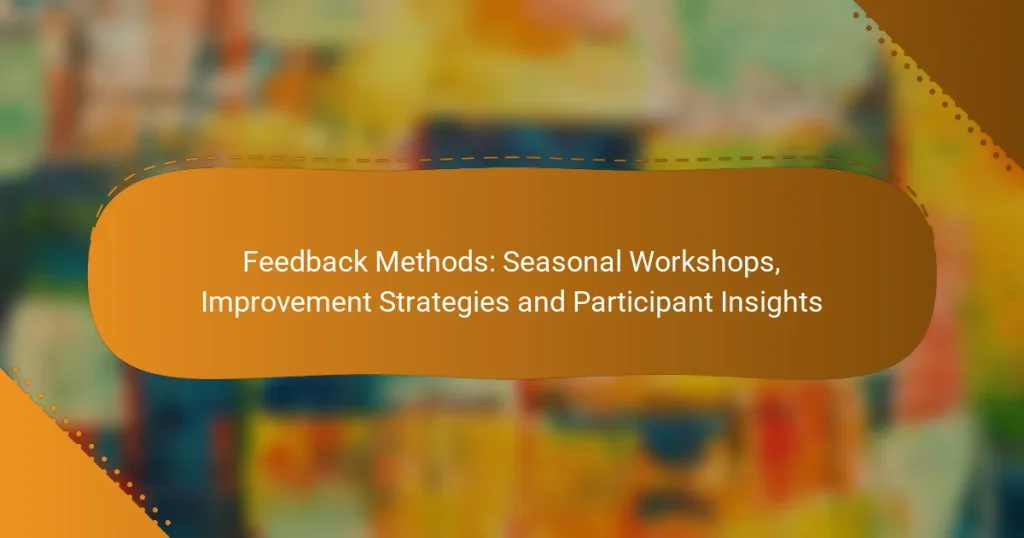Gathering effective feedback from seasonal workshops is essential for continuous improvement and participant satisfaction. By employing structured methods such as surveys and interactive discussions, organizations can gain valuable insights that inform future events. Implementing these feedback strategies not only enhances the overall experience but also fosters a culture of engagement and responsiveness among participants.

What are effective feedback methods for seasonal workshops?
Effective feedback methods for seasonal workshops include structured approaches that gather insights from participants to enhance future events. Utilizing a mix of surveys, discussions, and interactive tools can provide comprehensive feedback that drives improvement.
Surveys and questionnaires
Surveys and questionnaires are straightforward tools for collecting feedback from workshop participants. They can be distributed online or in paper format, allowing participants to share their thoughts anonymously, which often leads to more honest responses.
When designing surveys, focus on clear and concise questions that cover key aspects of the workshop, such as content relevance, delivery effectiveness, and overall satisfaction. Aim for a mix of quantitative ratings and qualitative open-ended questions to capture a range of insights.
Focus group discussions
Focus group discussions involve gathering a small group of participants to discuss their experiences and suggestions in a guided setting. This method encourages deeper conversation and can uncover insights that surveys might miss.
To conduct effective focus groups, select a diverse group of participants and prepare open-ended questions that stimulate discussion. Ensure a skilled facilitator guides the conversation to keep it on track and encourages participation from all members.
One-on-one interviews
One-on-one interviews provide an opportunity for in-depth feedback from participants. This method allows for personalized interaction, enabling interviewers to probe deeper into specific areas of interest or concern.
When conducting interviews, prepare a semi-structured format with key questions while allowing flexibility for follow-up queries. This approach can yield valuable insights, especially from participants who may be hesitant to share in group settings.
Interactive feedback tools
Interactive feedback tools, such as digital platforms or apps, allow participants to provide real-time feedback during the workshop. These tools can include features like live comment sections or rating systems that engage participants actively.
Consider using tools that are user-friendly and accessible on various devices. This method not only captures immediate reactions but also fosters a culture of open communication throughout the event.
Real-time polling
Real-time polling is an effective way to gauge participant opinions and understanding during the workshop. By using instant polling tools, facilitators can quickly assess the audience’s thoughts on specific topics or activities.
Implement polls at strategic points in the workshop to keep participants engaged and informed. Ensure that the questions are clear and relevant to the content being discussed, allowing for quick adjustments based on participant feedback.

How can improvement strategies enhance participant insights?
Improvement strategies can significantly enhance participant insights by systematically analyzing feedback and implementing changes that address specific needs. By utilizing structured methods, organizations can create a more engaging and effective experience for participants.
Data analysis techniques
Data analysis techniques involve collecting and interpreting feedback data to identify trends and areas for improvement. Common methods include surveys, interviews, and focus groups, which can provide qualitative and quantitative insights. Utilizing tools like spreadsheets or specialized software can help visualize data patterns effectively.
For example, a workshop may gather participant ratings on various aspects, such as content relevance and delivery style. Analyzing this data can reveal which areas need enhancement and which are performing well, guiding future workshop design.
Actionable feedback loops
Actionable feedback loops are processes that ensure participant feedback is not only collected but also acted upon. This involves regularly soliciting input, analyzing it, and then communicating changes back to participants. This transparency fosters trust and encourages ongoing engagement.
To implement effective feedback loops, consider setting up regular check-ins or follow-up surveys after each workshop. This allows participants to see how their insights have influenced improvements, reinforcing their value in the process.
Benchmarking against industry standards
Benchmarking against industry standards involves comparing your workshop outcomes and participant feedback with those of similar organizations or established best practices. This can help identify gaps and opportunities for enhancement, ensuring your strategies are competitive and relevant.
For instance, if the average satisfaction score in your industry is around 80%, and your workshops consistently score below that, it may indicate a need for significant changes. Researching industry reports or networking with peers can provide valuable insights into effective practices and standards.

What are the best practices for conducting feedback workshops?
Effective feedback workshops focus on structured approaches that encourage open dialogue and actionable insights. Best practices include setting clear objectives, creating a safe environment, and utilizing technology to enhance participant engagement.
Setting clear objectives
Establishing clear objectives is crucial for guiding the workshop’s direction and ensuring that participants understand the goals. Objectives should be specific, measurable, achievable, relevant, and time-bound (SMART). For instance, aim to gather feedback on a specific project or initiative within a defined timeframe.
Communicate these objectives at the beginning of the workshop to align expectations. This clarity helps participants focus their feedback, making it more relevant and actionable.
Creating a safe environment for sharing
A safe environment encourages participants to share honest feedback without fear of repercussions. Start by establishing ground rules that promote respect and confidentiality. For example, remind participants that all feedback is constructive and should be treated as such.
Facilitators can also use icebreakers or team-building activities to build trust among participants. This rapport fosters open communication, enabling more candid discussions about strengths and areas for improvement.
Utilizing technology for engagement
Incorporating technology can significantly enhance engagement during feedback workshops. Tools like online surveys, real-time polling, and collaborative platforms allow participants to share their thoughts anonymously, which can lead to more honest feedback.
Consider using interactive tools such as Miro or Mentimeter to visualize feedback in real-time. This approach not only keeps participants engaged but also helps in organizing thoughts and identifying common themes quickly.

How can organizations measure the effectiveness of feedback methods?
Organizations can measure the effectiveness of feedback methods by evaluating specific metrics that reflect participant engagement and outcomes. This includes analyzing key performance indicators, participant satisfaction scores, and conducting follow-up assessments to gauge long-term impact.
Key performance indicators (KPIs)
Key performance indicators (KPIs) are quantifiable measures that help organizations assess the success of their feedback methods. Common KPIs include attendance rates, completion rates of feedback forms, and the number of actionable insights generated from the feedback. Setting clear benchmarks for these indicators can guide improvements in future workshops.
For example, a workshop might aim for an attendance rate of at least 80% and a completion rate of feedback forms above 70%. Tracking these KPIs over time allows organizations to identify trends and make data-driven decisions.
Participant satisfaction scores
Participant satisfaction scores provide direct insight into how attendees perceive the feedback methods. Organizations can use surveys to gather scores on a scale from 1 to 10, asking participants to rate their overall experience and the relevance of the content. High satisfaction scores typically correlate with effective feedback methods.
To enhance accuracy, consider using a mix of quantitative ratings and qualitative comments. This dual approach helps organizations understand not only how satisfied participants are but also why they feel that way, allowing for targeted improvements.
Follow-up assessments
Follow-up assessments are crucial for measuring the long-term effectiveness of feedback methods. These can include additional surveys or interviews conducted weeks or months after the initial feedback session to evaluate how well participants have implemented the insights gained. This approach helps organizations understand the lasting impact of their workshops.
For effective follow-up, set a timeline for assessments, such as 30 or 60 days post-workshop. This allows enough time for participants to apply what they learned and provides a clearer picture of the feedback method’s effectiveness in driving change.

What tools can facilitate feedback collection?
Effective feedback collection tools streamline the process of gathering insights from participants, making it easier to analyze and implement improvements. Utilizing the right tools can enhance engagement and ensure that feedback is actionable and relevant.
Google Forms
Google Forms is a free tool that allows users to create customized surveys and questionnaires. It is user-friendly and integrates seamlessly with other Google services, making data collection straightforward and efficient.
To create a form, simply choose from various question types, including multiple choice, short answer, and rating scales. You can share the form via email or a direct link, and responses are automatically collected in a Google Sheet for easy analysis.
When using Google Forms, keep your questions clear and concise. Avoid leading questions that may bias responses, and consider using branching logic to tailor the survey experience based on previous answers.
SurveyMonkey
SurveyMonkey is a popular survey platform that offers a range of features for designing and distributing surveys. While it has a free tier, many advanced functionalities require a paid subscription, which can be worth the investment for larger organizations.
With SurveyMonkey, users can access templates, analyze results with built-in analytics tools, and export data in various formats. This platform is particularly useful for conducting in-depth surveys, as it allows for complex question types and custom branding options.
When using SurveyMonkey, ensure that your survey is not too lengthy to avoid participant fatigue. Aim for a completion time of under 10 minutes to maintain engagement and increase response rates.


